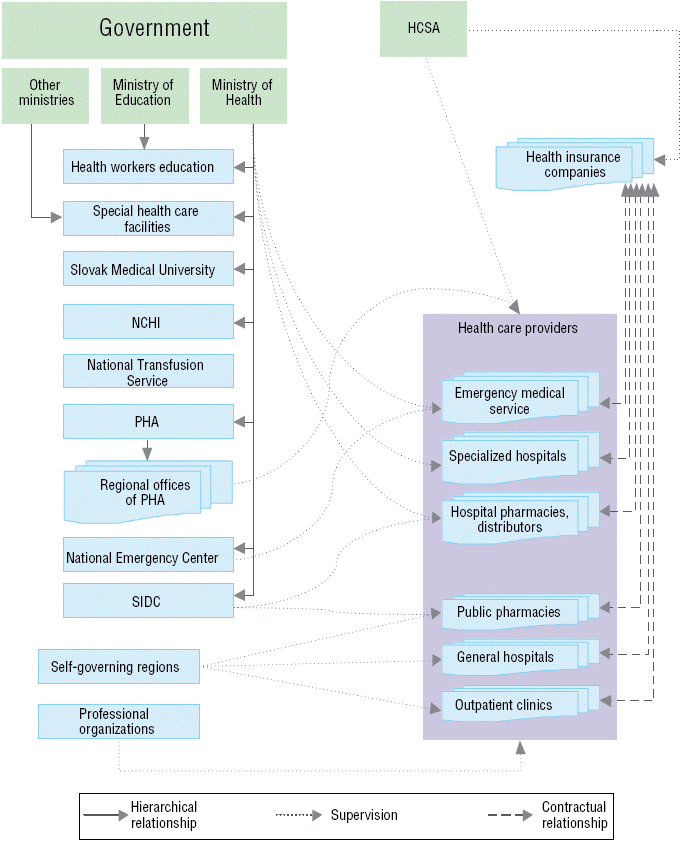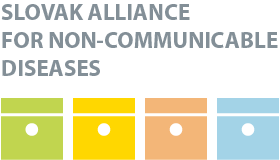—
HPI Network > HPI - Health Policy Institute > Health System in Slovakia > 2. Organization and governance > 2.1 Overview of the health system
2.1 Overview of the health system
Wednesday, 04. May 2011, 21:29 — HPI
|
2. Organization and governance |
Introduction – Organization – Financing – Resources – Provision – Reforms – Assessment – Conclusions – Appendices |
2.2 Historical background |
The health care system in Slovakia (see Fig. 2.1) is based on universal coverage, compulsory health insurance, a basic benefit package and a competitive insurance model with selective contracting and flexible pricing. Health care, with exceptions, is provided to insured individuals for free as benefits-in-kind (paid for by a third party). After fulfilling certain explicit criteria, there are no barriers to entry to the health care provision and health insurance markets.
Fig 2.1: Organizational overview of the health system

Based on the quality of their services, health insurance companies compete for insured individuals. Health care purchasing creates room for competition. Health insurance companies are obliged to ensure accessible health care to their insured according to provisions laid down by law. Health insurance companies fulfil this obligation by contracting health care providers. The HCSA is responsible for monitoring health insurance, health care provision and health care purchasing markets. Since 2005, all health insurance companies are joint stock companies, that is, they were transformed from (public) health insurance funds to health insurance companies operating under the Business Code. As of 2010, three health insurance companies operate on the market, one state-owned and two privately owned.
Different ownership structures characterize health care providers and health insurance companies. The state, represented by the Ministry of Health, is the owner of the largest health insurance company. Furthermore, the state owns the largest health care providers, including university hospitals, large regional hospitals, highly specialized institutions and almost all psychiatric hospitals and sanatoria. The majority of them are contributory organizations. This is a Slovak form of legal entity that is established by a government (including regional and municipal governments), to which part of the entity’s budgets are linked; that is, they may have other revenue sources (for example, payments by health insurance companies). In 2006, five state-owned health care facilities were transformed into 100% state-owned joint stock companies. Since 2007, the health care facilities in state ownership must be contracted by health insurance companies. The then government saw them as crucial in guaranteeing geographical accessibility but critics argued that this also gave these hospitals an unfair competitive advantage. Health departments of the Ministry of Defence, Ministry of Transport, Ministry of the Interior and Ministry of Justice manage several health care facilities of their own.
Pharmacies and diagnostic laboratories, as well as almost 90% of outpatient facilities, are in private hands. Some outpatient specialists are employed by hospitals and provide ambulatory care in polyclinics attached to hospitals. Providers of emergency health care services are either in private or state ownership. Four-year operating permits are issued by the Ministry of Health based on a successful tender.
State bodies (Ministry of Health, HCSA) and self-governing regions, which have regional competences, mainly in outpatient care, administer the system and issue permits to health care providers. Organized interest groups also participate in health policy-making. Although they are invited to comment on legislative proposals, their recommendations carry relatively little political weight. Representatives of employees and employers meet with government representatives at the Tripartite Economic and Social Council, but their mutual agreement is not required to continue the legislative process. Professional organizations keep registers of health professionals and they issue or revoke licences. They cooperate in monitoring the management of health care facilities and issue opinions on ethical issues concerning the medical profession.Membership of these professional organizations is not compulsory.
A more elaborate description of the various actors in Slovak health care can be found in section 2.3.
News
The amendment of the Decree on emergency medical service
Health insurance companies returned over 400 thousand €
The HCSA received 1,647 complaints last year
A half million people will earn more
Most of public limited companies ended in the black
Debt of hospitals on premiums has grown to nearly € 105 MM
Slovak health care may miss € 250 million next year
Profits of HIC amounted to € 69 mil. last year
Owners of Dôvera paid out money but did not paid taxes
Like us on Facebook!
Our analyses
- 10 Years of Health Care Reform
- New University Hospital in Bratislava
- Understanding informal patient payments in Kosovo’s healthcare system
- Analysis of waiting times 2013
- Health Policy Basic Frameworks 2014-2016
- Analysis of informal payments in the health sector in Slovakia
- Serbia: Brief health system review
developed by enscope, s.r.o.
